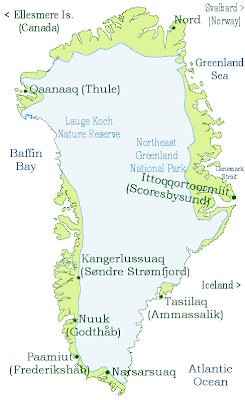We're Back
We're back online after an intense period of working on the bot. Over our spring break we heard that NSF accepted our impromptu proposal and decided to stage us in Greenland on a traverse connecting the Thule air force base with the Summit station in Greenland. The purpose of the trip is to resupply the Summit Station, and we'll be testing Yeti's effectiveness at detecting crevasses alongside a Tucker Sno-Cat with radar.
Kevin and I will be heading to Qaanaaq, Greenland (Thule) with Yeti, about as far north as we can possibly go. If you know how to pronounce Qaanaaq, please let me know. At the end of the winter, we had a working robot, but the user interface was rudimentary, the GPS functionality nonexistant, and the robot was not prepared to drive outside. With only two team members left working on the project, we've been working around the clock to get ready in time.

Our Carlon supplier informed us this week that the enclosures we ordered 7 weeks before would not be available until June. We pulled the order, spent a day in the CAD lab, and overnighted some stock material and after several days of breathing fiberglass dust, we ended up with a couple of sweet bulletproof fish tanks to protect Yeti's electronics in snow and -40 degree temperatures.
Ken Corcoran from GSSI came up to Dartmouth on Tuesday to deliver our SIR-3000 GPR unit and work with us to integrate the radar with the GPS and the wheel encoders. This took a monumental effort to get Yeti ready in time, and Kevin and I put in 30 hours in two days to get Yeti buttoned up and ready to go. We finished at 5:00 on Tuesday morning, took a quick nap, and met Ken at Thayer.
We ran into surprisingly few problems integrating the GPR unit with Yeti's electronics. Yeti's power board was able to supply the GPR with enough power and we were able to synch the GPR with Yeti's wheel encoders without issue. The one problem we faced was that the Garmin GPS we were using was never able to see more than three satellites, and the GPR requires at least 4. We're crossing our fingers that we'll have better luck in Greenland, since we've heard that satellite visibility is excellent where we'll be testing.
Kevin and Ken testing the GPR
Ken also helped us out by building a plate to hold the GPR antenna inside the tow sled which will help us out quite a bit.
Yeti is shipping out to get crated on a C5 transport plane on Monday, so we'll be racing in the machine shop the next two days to get everything entirely finished. Ken was justifiably not impressed with our 10-minute job on the towing mechanism, which was our lowest priority up to this point, so we'll be building a better rig to tow the radar
In our spare time, we've been updating the Yeti software to make the manual driving more intuitive and add the GPS functionality. We've been remarkably successful in getting this software to work so we're hoping that everything we develop in the week after we ship Yeti will work when we get to Greenland.
We'll be posting pictures and video from Thule so check back frequently.

1 Comments:
Hello Eric and Crew
My wife Sue and I lives in Thule. We can inform you, meny people go "Thule Trippin' wiht use of handhold Garmin GPS. I beleive there are several Satellits to "hook up to".
Thought you wanted to know.
Have a great traverse to Neem and summit.
Lars
Post a Comment
Subscribe to Post Comments [Atom]
<< Home